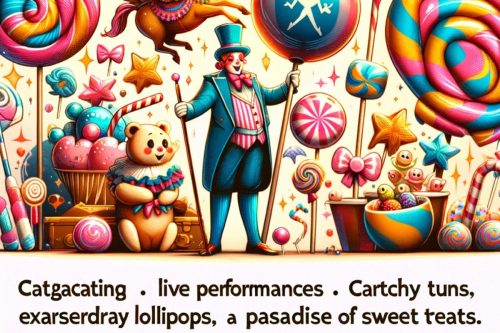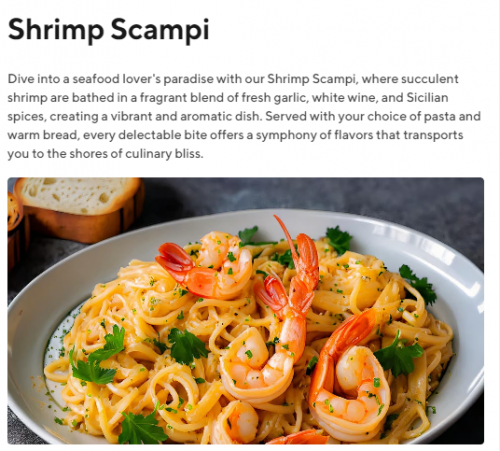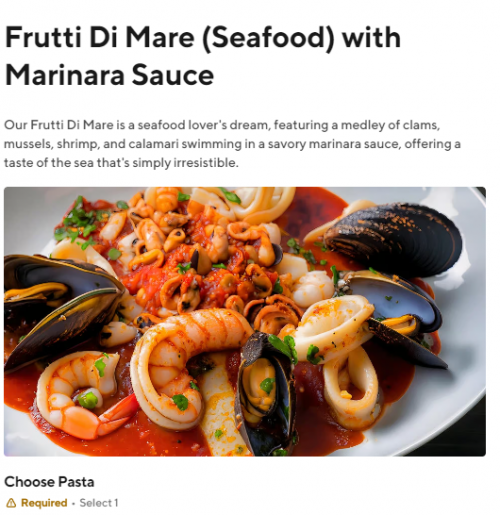Last week, everyone was talking about this scammy entertainment fiasco in Glasgow — someone had thrown together an event built around the Willy Wonka IP called Willy’s Chocolate Experience, charged $45 admission, and then thought they’d sit back and rake in the money. Instead, they were laughed at and despised. It was such an obvious failure — they rented a warehouse, put up a few plastic props, and hired a couple of actors with no script and no plan to stand around and improvise. Where they figured they could really cut costs even further was to use AI to generate the advertising and some of the displays in the warehouse.
They didn’t even copy-edit their ads. It was a zero-effort effort that they thought they could mask with some garishly colored AI art. The appalling thing was how little substance there was behind the glitzy facade — kids showed up and instead of smorgasbord of chocolate they got one jelly bean and a cup of lemonade. That’s how I’ve felt about all the AI stuff being churned out right now. It’s mostly empty hyper-stimulus where the fantasy gets dressed up in an excess of colorful noise. The Glasgow thing was just an example of a few profiteers thinking that was sufficient. It’s not.
Then I encountered another illuminating example. Product photography is a whole genre unto itself, where you have to take photographs of things that are being sold in a way that makes them revealing and enticing. Food photography is a difficult art, because you have to take something that is kind of gross and drab if you think about — a lump of meat with sauces gooped over it, for instance — and make it look crisp and shiny and delicious and colorful (but not too colorful). The food photographed for menus and ads is already mostly fake, with condensation made of glycerin, foamy heads made with soap, cardboard padding to make a stack stand up, and ice cream made out of mashed potatoes.
Commercial food photography is actually pretty hard to do well, as you can discover on Instagram where amateurs are constantly taking photos of their luxury meals, and making them look generally ick. It’s expensive because that photograph of a plump hamburger covered in slightly melting cheese and bright red tomatoes and crisp green lettuce actually takes a team of designers and lighting experts and good photographers to shoot. So why not cut out that expense by using AI to assemble an image from all the hard work of real artists? It’s mostly fake anyway.
These mass market ghost kitchens are doing exactly that.
Dozens of Ghost kitchens, restaurants that serve food exclusively by delivery on apps like DoorDash and Grubhub, are selling food that they promote to customers with AI-generated images. It’s common for advertisements to stage or edit pictures of food to make it look more enticing, but in these cases the ghost kitchens are showing people pictures of food that literally doesn’t exist, and looks nothing like the actual items they’re selling, sometimes because the faulty AI is producing physically impossible food items.
In a way, it’s kind of cool. I look at their products with the eye of a biologist, and their crustaceans and molluscs definitely seem to be alien.
The more I look at those things, the weirder they are. What’s going on with that shrimp’s terminal segment? Those telsons don’t make any sense. Would you eat meat that looked like it had been recently imported from Arcturus, or came from animals cultured downstream from a nuclear power plant?
I guess it may not matter, because we don’t generally scrutinize the photographs in a menu that carefully. They’ve got the color and shininess and appearance of an expected plate of food, so that’s good enough. I might be the only person who’d send the meal back, complaining that these are mundane terrestrial bits of cooked animal flesh.
They better not disappoint me with the beverage, though. I really want my glass of radioactive diet Sprite.





Beware the Arcturian, my son!
The shrimps that swim, with telsons unnatch!
(Also beware the Jubjub bird, and shun
The frumious Bandersnatch!)
The apex of civilization was reached with Japanese restaurant plastic food displays. It’s been all downhill from there.
You’re imagining that the AI art is replacing food photographers, but it’s probably a further step removed. Why hire food photographers to create photos of your food, when you can just purchase pre-made stock photos? I mean, if they’ve already decided that the photo will bear no relation to the actual food.
You want food that looks like it will bust out of your chest if you do not chew it properly?
One of my aunts worked for General Foods in White Plains, NY for many years. One time she came to California in probably mid to late 50’s to be on a local TV food program in Los Angeles. She was showing off some product to go with holiday turkey. I thought it was Stove Top Stuffing, but that came out much later. Any way, we lived near enough to LA that she stayed with us. She went to the local market to get a turkey. The market of course had a full service meat counter. She told the butcher that she needed a turkey, and why. He assumed it should be cooked. When she picked it up, he, wanting to be helpful, had roasted it. Oops! That was not how you made a turkey look perfectly cooked back then. You took a raw turkey and coated it with maple syrup. I don’t remember if she used it anyway, or had to scramble to get a new one.
Hey! Don’t knock the “Willy’s Chocolate Experience” people. It was three jelly beans and 1/4 cup of lemonade. (there’s a 4 in there so it must be more. Like the 1/3 pounder lost out to the 1/4 pounder in sales)
Who is providing the Sweet Teats? Chocolate milk cows?
I saw a special on TV some time back that showed the secrets of how they make the food in advertisements look so tasty good. Think of how great a Bic Mac looks in the ad compared to a real one. I don’t recall the tricks they showed (like maple syrup to make a turkey look perfectly cooked) but their results were 100X better than these AI ones. Humans rule.
I really want to know more about the catgacating, which I assume is some kind of DNA splicing event.
They could always put the time money and expense involved in fakery into producing real food instead of plastic Macs.
I didn’t pay much attention to this fiasco.
But did the scammers even have any of the rights to Willy Wonka?
He is a character in the book Charlie and the Chocolate Factor.
Not in the public domain.
Warner owns the rights.
Warner snapped up the rights to the Wonka intellectual property from the Roald Dahl Estate way back in 2016 and has been developing the project since then.Dec 7, 2023
From the article in the OP.
The fine print.
“Any resemblance to any character, fictitious or living, is purely coincidental.” A work of pure imagination, if you will.”
No, they didn’t have any right to the Willy Wonka Intellectual Property.
This was a lot like the recent Fyre Festival in the Bahamas.
At least the ticket holders weren’t stuck in the middle of the Atlantic.
raven, see the video I adduced.
It was called “Willy’s Chocolate Experience” and featured Willy McDuff and the Wonkidoodles.
Has anyone seen any of the recent interviews of Billy Joel? He came out of retirement from song-writing and collaborated with a young song writer. The young man created the video for the song using AI to make it appear that Billy, at different stages of his career, was singing the new song. It looked to be very well done and a bit mind-blowing.
I’ve seen the interviews on The Late Show and Fareed Zakaria GPS. I recommend Fareed’s interview, since he also interviews the young man and goes into greater depth.
AI can be used for good or evil. Sadly, humans will most likely choose to use it for evil. This young songwriter is an exception.
In the news: Trump supporters target black voters with faked AI images
I’ll pass on the radioactive Sprite. However, I miss Jolt Cola…
The only food that should be “radioactive green” is the pickle relish that goes on Chicago Hot Dogs.
IIRC, modern advertising law now require that the product being sold is used in the advertisement- no more mashed potatoes standing in for ice cream or maple syrup-glazed raw turkeys. However, what is allowed is sorting through hundreds or thousands of samples to find the one perfect tomato slice, one perfect patty, one perfect lettuce leaf, and one perfect bun to display a perfect-looking burger that doesn’t resemble what you’ll get when you unwrap the one you ordered.
microraptor, from Harvard Law Today Sep 13, 2023:
(https://hls.harvard.edu/today/harvard-law-expert-explains-the-burger-king-false-advertising-lawsuit/)